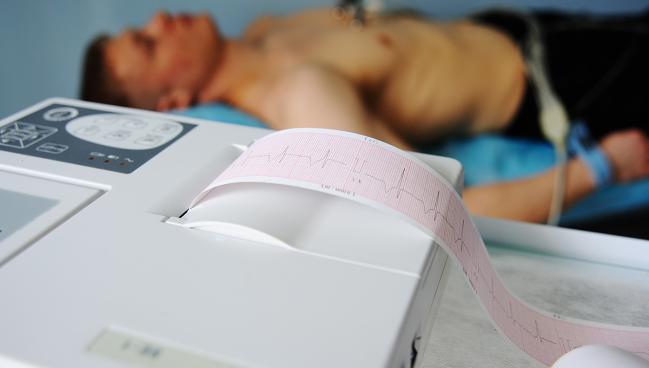ECG Abnormalities on Routine Screening Tied to CVD Events in Large Study
What’s still missing is evidence about what can be done in response to the findings, one expert says.

Even minor ECG abnormalities detected with annual checks signal a greater risk of future CVD events, a study of several million working-age people affirms, although questions remain about whether there is a net benefit to such routine screening.
Individuals with any minor or major abnormalities on a standard resting 12-lead ECG had significantly increased risks of overall death or hospitalization for MI, stroke, or heart failure over the next several years compared with those with normal ECGs, according to researchers led by Ryuichiro Yagi, MD (Brigham and Women’s Hospital and Harvard Medical School, Boston, MA).
In addition, even one minor abnormal finding was associated with a greater likelihood of developing a major abnormality on a subsequent screening ECG, they report in study published online this week in JAMA Internal Medicine.
Speaking with TCTMD, Yagi noted that these findings were seen in individuals with all levels of predicted risk of CVD, including those deemed to be at low risk, “which might suggest the utility of ECG in that population. However, this finding does not necessarily support routine ECG screening.”
That assessment is in line with the US Preventive Services Task Force (USPSTF), which in 2018 came out with a recommendation against routine ECG screening for CVD in asymptomatic adults at low risk for disease. They concluded that for those at higher risk, there was insufficient evidence to weigh the risks and the benefits. Although routine ECG screening has been proposed as a way to identify individuals at high risk for CVD, in whom preventive therapies can be initiated, there is a lack of evidence showing this approach makes a meaningful impact on clinical outcomes. And there are potential downsides, including unnecessary follow-up tests and procedures, as well as patient anxiety.
Alex Krist, MD (Virginia Commonwealth University, Richmond), was a member of the USPSTF when that recommendation was made, but spoke with TCTMD to provide his personal views on the issue. “I don’t think that this study changes my perspective of what we know and what we don’t know about the role of EKGs for routine screening for cardiovascular disease prevention,” he said.
“It gives us a lot more assurance that these abnormal EKG findings are linked to cardiovascular disease,” he continued, “but we’re still kind of lacking: what do we do in response and does this result in helping more people? And what are the specific harms of doing this?”
The Japanese Experience
Multiple prior studies have identified a link between ECG abnormalities and future CVD events, although much of the research was conducted in the 1980s and 1990s and involved smaller, selected patient groups, Yagi noted.
In Japan, a resting ECG is frequently performed as part of routine CVD screening mandated by the government, providing an opportunity for the researchers to explore this issue further. For the current study, Yagi and colleagues examined the Japan Health Insurance Association database, which covers about 40% of the working-age population in the country (approximately 30 million people). The analysis focused on people ages 35 to 65 who underwent a standard resting 12-lead ECG between April 2015 and March 2022 as part of the annual health check program and who had no history of CVD or major ECG abnormalities in the year prior to baseline in 2016.
We need to know that by finding something and doing something differently, we’re changing activities and that improves the health outcomes for people. Alex Krist
Of nearly 3.7 million people (mean age 47.1; 66.6% men) included in the study, 16.8% had one minor ECG abnormality, 3.9% had at least two minor abnormalities, and 1.5% had a major abnormality identified on the baseline ECG.
Through a median follow-up of 5.5 years, 4.2% of individuals had a primary outcome event (overall death or hospital admission for MI, stroke, or heart failure). Any ECG abnormality was associated with a greater risk compared with a normal test:
- One minor abnormality (adjusted HR 1.19; 95% CI 1.18-1.20)
- Two or more minor abnormalities (adjusted HR 1.37; 95% CI 1.34-1.39)
- Major abnormality (adjusted HR 1.96; 95% CI 1.92-2.02)
These findings were consistent irrespective of baseline estimated 10-year risk of CVD, when the two components of the primary outcome were assessed individually, and across various subgroups defined by age, sex, and clinical features.
Moreover, finding minor abnormalities at baseline was associated with a greater risk of having a major abnormality detected during follow-up, with an adjusted HR of 2.52 for one minor finding and 3.61 for two or more minor findings.
In terms of follow-up testing, a subsequent echocardiogram was performed for 2.6% of those with a normal ECG, 4.3% to 5.6% of those with minor abnormalities, and 26.0% of those with a major abnormality. The corresponding rates of coronary angiography were 0.2%, 0.3% to 0.4%, and 1.2%.
“The findings of this study suggest that the potential role of routine ECG screening for early prevention of CVD events, along with the optimal follow-up strategy, should be examined in future studies,” the authors write.
Benefit of Screening Still Unclear
What this study adds to the conversation around routine ECG screening is the scope and depth of the population and the long follow-up, Krist, who wrote an accompanying commentary, told TCTMD. “It probably gives us the best estimate of the associations between abnormal EKG findings and cardiovascular events in a working-age, 35- to 65-year-old population.”
He said two major pieces of evidence are still lacking when considering whether to implement this type of routine screening, however. One is an assessment of the harms of this approach, which can encompass subsequent tests and procedures as well as anxiety and other consequences of a patient knowing they have a finding linked with a greater risk of CVD but no clear direction as what to do about it, Krist said.
And second, he continued, is the question of whether benefits outweigh those harms. “We need to know that by finding something and doing something differently, we’re changing activities and that improves the health outcomes for people, and not just merely that we’re finding something.”
Speaking about his clinical experience as a family medicine physician, Krist pointed out that “having an EKG with minor abnormalities actually creates a lot of confusion. So, most doctors look at this and we just kind of shrug our shoulders and we don’t know what to do.”
Yagi observed that most major ECG abnormalities have defined pathways for further workup, while most minor abnormalities do not. And even though this study suggests that assessing the types and numbers of minor abnormalities “could play an important role in certain populations to mitigate the CVD risk, [that] requires further investigation. . . . We have to assess both the benefit and harm of ECG screening carefully.”
Todd Neale is the Associate News Editor for TCTMD and a Senior Medical Journalist. He got his start in journalism at …
Read Full BioSources
Yagi R, Mori Y, Goto S, et al. Routine electrocardiogram screening and cardiovascular disease events in adults. JAMA Intern Med. 2024;Epub ahead of print.
Krist AH. Screening ECGs for cardiovascular risk assessment. JAMA Intern Med. 2024;Epub ahead of print.
Disclosures
- The study was supported by a research grant from the Japan Health Insurance Association.
- Yagi reports receiving grants from the American Heart Association Postdoctoral Fellowship.
- Krist reports no relevant conflicts of interest. He was a member of the USPSTF when the group made its latest recommendations on ECG screening for the prevention of CVD events.





Comments